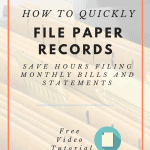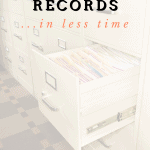When it comes to your bills and statements, it can be hard to know what to save and how to save it.
As a Professional Organizer, I’m often asked for help with organizing home paperwork. With new bills and statements arriving every month, it’s important to develop a filing system that’s straightforward, simple, and sustainable for the long-term.
To help you get a handle on your paperwork, I’ll be showing you how to organize important documents at home — with just a few minutes of your time every month. You can learn this easy system in the video below or by continuing to read this blog. Let’s get started!
1. Consider going electronic
While this isn’t an actual part of your home filing system, it’s something I encourage all of my clients to consider. Most companies and services offer electronic billing options, which can drastically cut back on your clutter and your paper waste. If you don’t own a computer or just prefer to receive paper, however, the system I’m about to teach you is a great way to manage your paperwork without wasting space.
2. Construct a retention schedule
A retention schedule details the documents you want to keep and how long you want to keep them. I usually recommend hanging on to most bills and financial statements for about a year, though you can determine the best option for your files.
3. Create a hanging file for every month
Making a separate folder for every bill is the biggest mistake I see clients make. These files tend to quickly add up, holding years’ worth of bills and creating a mess within your organizing system. Instead, use 12 hanging file folders to create a holding space for each month’s files. Now, these files aren’t for your permanent records, such as marriage or birth certificates. Instead, use this home paperwork storage solution for your recurring, monthly bills and statements. You’ll be able to store them all in one place, keeping your filing system simple and your documents easy to find.
4. Clean your home filing system every year
With this home filing system, you’ll only encounter an already full file when it’s time to toss the old bills and statements. When January rolls around again, for example, you can simply empty the folder into the trash before beginning to file the current year’s paperwork. It’s really that easy!
While this system is perfect for monthly paperwork, it does not work for business files or other important documents. To help you manage your paperwork storage in every situation, I’ve put together a playlist with additional tips for paper organizing. Explore the videos in this YouTube playlist for less filing frustration and a filing system that works.














